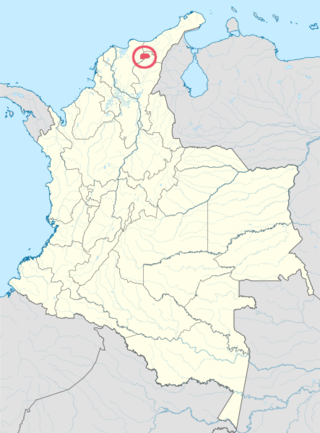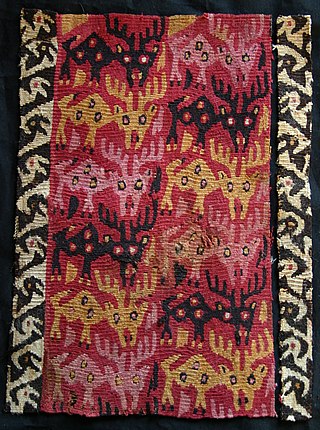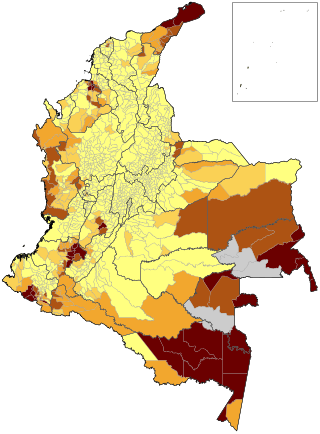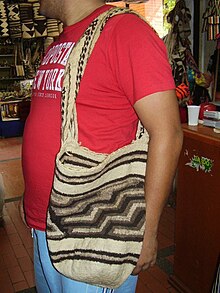
Valledupar is a city and municipality in northeastern Colombia. It is the capital of Cesar Department. Its name, Valle de Upar, was established in honor of the Amerindian cacique who ruled the valley; Cacique Upar. The city lies between the mountains of the Sierra Nevada de Santa Marta and the Serranía del Perijá to the borders of the Guatapurí and Cesar rivers.

Ciudad Perdida is the archaeological site of an ancient city in the Sierra Nevada de Santa Marta of Colombia, within the jurisdiction of the municipality of Santa Marta. This city is believed to have been founded about 800 AD. If so, Ciudad Perdida predates Machu Picchu by about 650 years.

Tairona or Tayrona was a Pre-Columbian culture of Colombia, which consisted in a group of chiefdoms in the region of Sierra Nevada de Santa Marta in present-day Cesar, Magdalena and La Guajira Departments of Colombia, South America, which goes back at least to the 1st century AD and had significant demographic growth around the 11th century.

The Sierra Nevada de Santa Marta is an isolated mountain range in northern Colombia, separate from the Andes range that runs through the north of the country. Reaching an elevation of 5,700 m (18,700 ft) just 42 km (26 mi) from the Caribbean coast, the Sierra Nevada is the highest coastal range in the tropics, and one of the highest coastal ranges in the world, being 250 metres (820 ft) shorter than the Saint Elias Mountains in Canada. The Sierra Nevada encompasses about 17,000 km2 (6,600 sq mi) and serves as the source of 36 rivers. The range is in the Departments of Magdalena, Cesar and La Guajira.

The Wayuu are an Indigenous ethnic group of the Guajira Peninsula in northernmost Colombia and northwest Venezuela. The Wayuu language is part of the Arawakan language family.

The Arhuaco are an indigenous people of Colombia. They are Chibchan-speaking people and descendants of the Tairona culture, concentrated in northern Colombia in the Sierra Nevada de Santa Marta.

The Kogi, or Cogui, or Kágaba, meaning "jaguar" in the Kogi language, are an indigenous group that resides in the Sierra Nevada de Santa Marta mountains in northern Colombia. Their culture has continued since the Pre-Columbian era.

Pueblo Bello, is a village and municipality in the northern region of the Department of Cesar, Colombia. It is located in the mountains of the Sierra Nevada de Santa Marta and is home to Amerindians pertaining to the Arhuaco ethnicity, whom consider Pueblo Bello a sanctuary but by the name of Arumake in their language. Pueblo Bello is the main producer of coffee in the Caribbean Region of Colombia.
The manufacture of textiles is one of the oldest of human technologies. To make textiles, the first requirement is a source of fiber from which a yarn can be made, primarily by spinning. The yarn is processed by knitting or weaving, which turns it into cloth. The machine used for weaving is the loom. For decoration, the process of colouring yarn or the finished material is dyeing. For more information of the various steps, see textile manufacturing.

Tourism in Cesar Department refers to the tourism in the Colombian Department of Cesar. Tourism developed primarily in Valledupar during the middle of the 20th century after the creation of Cesar Department, but had its precedents in religious peregrination during the Holy Week, Catholic Church tradition with peregrines going to Valledupar to celebrate processions, religious masses, saint of Ecce Homo veneration, the Virgen del Carmen, among others, these peregrinations were also popular in Atanquez a small village enclaved in the Sierra Nevada de Santa Marta, were the local culture inherited from the Spanish and Indigenous develop the "devil dancers".
The Symbols of the Department of Magdalena are the official symbols adopted by the Government of the Colombian Department of Magdalena to represent the identity of the Department of Magdalena as a subnational. These symbols intend to represent the Magdalenian identity by creating visual, verbal, and culturally iconic representations of Magdalena's history, culture, peoples, values and goals.

Atanquez or San Sebastian is a Colombian town and corregimiento of Valledupar in the Department of Cesar. Atanquez is located on the Sierra Nevada de Santa Marta mountain range at approximately 2,000 m over sea level. Atanquez is known for being predominantly inhabited by the indigenous ethnic group Kankuamos among others and mestizo groups.

Paraguayan Indigenous art is the visual art created by the indigenous peoples of Paraguay. While indigenous artists embrace contemporary Western art media, their arts also include pre-Columbian art forms. Indigenous art includes ceramics, baskets, weaving and threading, feather art and leather work. It is a hybrid nature includes the embroideries, lace, woodcarving and different metal products. Paraguay is particularly known for its indigenous featherwork and basket weaving.

Arhuaco, commonly known as Ikʉ, is an Indigenous American language of the Chibchan language family, spoken in South America by the Arhuaco people.

The textile arts of the Indigenous peoples of the Americas are decorative, utilitarian, ceremonial, or conceptual artworks made from plant, animal, or synthetic fibers by Indigenous peoples of the Americas.

A bag is a common tool in the form of a non-rigid container, typically made of cloth, leather, paper, or plastic. The use of bags predates recorded history, with the earliest bags being lengths of animal skin, cotton, or woven plant fibers, folded up at the edges and secured in that shape with strings of the same material. Bags can be used to carry items such as personal belongings, groceries, and other objects. They comes in various shapes and sizes, often equipped with handles or straps for easier carrying.

Hidalgo (state) handcrafts and folk art are mostly made for local consumption rather than for collectors, although there have been efforts to promote this work to a wider market. Most are utilitarian and generally simply decorated, if decorated at all. The most important handcraft traditions are pottery, especially in the municipality of Huejutla and textiles, which can be found in diverse parts of the state. Most artisans are indigenous, with the Otomi populations of the Mezquital Valley being the most dominant. Other important handcrafts include basketry, metal and wood working.

The Kankuamo, Kankuaka, Kankui or Kankuané are an indigenous people of Colombia, living on the southern slopes of the Sierra Nevada de Santa Marta up until the north of the César department. The Kankuamo people, estimated at 15,000 individuals, speak Sánha, a dialect of the Atanque language of the Chibcha family. Their laws are borne from nature and they consider the Sierra Nevada de Santa Marta, the highest mountain range closest to the sea, as sacred. In their native tongue they call this Umunukunu. Many Kankuamo, mostly merchants, do not speak their native language.

The Santa Marta páramo (NT1007) is an ecoregion containing páramo vegetation above the treeline in the Sierra Nevada de Santa Marta mountain range on the Caribbean coast of Colombia. The isolated position of the range has allowed unique species to evolve. Some are related to those found in Central America and the Caribbean coastal areas, and some to species from the Andes. The habitat is relatively stable, but has been drastically changed from the original by long-term human activity.


















